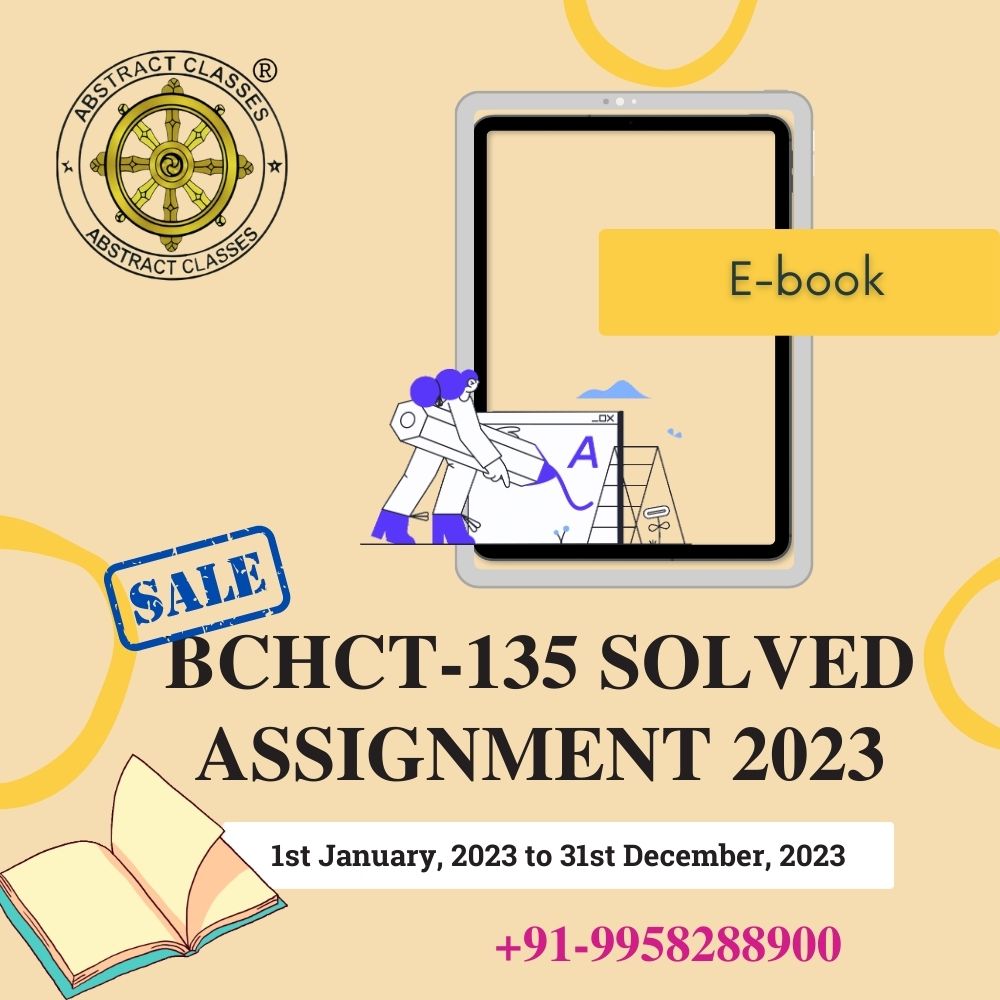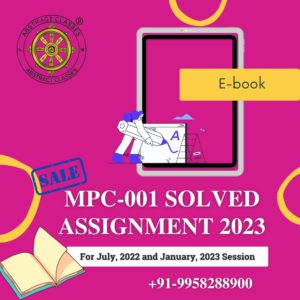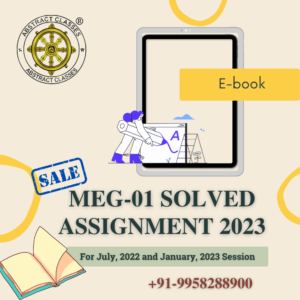
IGNOU BCHCT-135 Solved Assignment 2023 | B.Sc (G) CBCS
₹101.00
Please read the following points before ordering this IGNOU Assignment Solution.
Share with your Friends
IGNOU BCHCT-135 Assignment Question Paper 2023
Course Code: BCHCT-135
Assignment Code: BCHCT-135/TMA/2023
Maximum Marks: 100
PART-(A)
1. (a) What are ideal solutions? Give two examples of such solutions.
(b) Draw and explain the vapour pressure curves for an ideal solution.
2. Draw and explain the mutual solubility curve for the phenol-water system.
3. (a) How do the impurities Affect the CST values? Explain.
(b) Explain the stability of different phases of a pure substance in terms of chemical potential versus temperature curves.
4. Define any five of the following terms:
(i) Phase
(ii) Azeotropes
(iii) Congruent melting
(iv) Concentration cell
(v) Conductometric titration
(vi) Galvanic cells
5. (a) What is the criterion for phase equilibrium for a heterogeneous system at constant pressure and temperature?
(b) Define components in the context of phase rule. Calculate the number of components for the sublimation equilibrium of \(\mathrm{NH} 4 \mathrm{Cl}\) assuming that \(\mathrm{NH}_3(\mathrm{~g})\) and \(\mathrm{HCl}(\mathrm{g})\) are produced from the sublimation of \(\mathrm{NH}_4 \mathrm{Cl}(s)\) only.
6. (a) What is the triple point for a one component system? What is the degrees of freedom at the triple point?
(b) Draw and explain the phase diagram for a simple eutectic system and give an industrial application for the same.
7. (a) Define molar conductivity and give its significance.
(b) In a conductivity cell, the two platinum electrodes, each having an area of \(2 \mathrm{~cm}^2\) are \(1 \mathrm{~cm}\) apart. Using this cell the resistance of a \(0.1 \mathrm{M}\) solution of acetic acid is found to be \(470 \Omega\). Calculate the molar conductivity of the solution.
8. (a) List the requirements for an electrolyte to be indicator electrolyte in the moving boundary method for the determination of transference numbers’
(b) In the determination of transference numbers of \(\mathrm{HCl}\) by moving boundary method a \(0.10 \mathrm{M}\) solution of \(\mathrm{HCl}\) was taken in a cell having uniform area of cross section of \(1.0 \mathrm{~cm}^2\). At the end of experiment the boundary moved by \(10.3 \mathrm{~cm}\) and \(0.132 \mathrm{~g}\) of silver was deposited on the cathode of silver coulometer. Calculate the transference numbers of ions of \(\mathrm{HCl}\).
9. (a) Differentiate between reversible and irreversible cells.
(b) Write the cell diagram for a galvanic cell in which the following reaction takes place.
\[
\mathrm{Sn}(\mathrm{s})+2 \mathrm{Ag}^{+}(\mathrm{aq}) \rightarrow \mathrm{Sn}^{2+}(\mathrm{aq})+2 \mathrm{Ag}(\mathrm{s})
\]
Assume that potassium nitrate is used as electrolyte in the salt bridge and the concentrations of tin ions and silver ions are \(c_1\) and \(c_2\) respectively.
10. (a) Define electrolysis. Name the gases evolved in the electrolysis of brine.
(b) Define liquid junction potential and describe its development.
PART-(B)
11. Discuss the mechanism of Hell-Vohlard-Zelinsky reaction.
12. Write the mechanism and the products formed for the following reactions:

13. (a) Give the IUPAC names of the following compounds:

(b) Briefly explain the following reactions:
(i) Hofmann rearrangement
(ii) Schmidt rearrangement
14. (a) How will you prepare the following compounds? Give reactions.
(i) 4-methylbiphenyl
(ii) 4-hydroxyazobenzene
(iii) butter yellow dye
(b) How will you convert 4-bronobenzenmine to 4-bromobenzenol?
15. (a) Discuss the nitrosation reaction of primary amines.
(b) Discuss the nitration reaction of aniline. How would you account for the formation of different products?
16. (a) What is electrophoresis? Briefly explain. Also give its importance.
(b) What BOC-group? Which reagent is used to introduce this group?
17. How will you synthesise valine using Gabriel phthalimide synthesis?
18. Discuss the secondary structure of peptides.
19. (a) Briefly explain the phenyl osazone formation by monosaccharides.
(b) Why do D-(+)-glucose and D-(+)-mannose give the same osazone?
20. (a) What are polysaccharides? Give examples.
(b) Briefly explain the structure aspects of starch.
BCHCT-135 Sample Solution 2023
Frequently Asked Questions (FAQs)
You can access the Complete Solution through our app, which can be downloaded using this link:
Simply click “Install” to download and install the app, and then follow the instructions to purchase the required assignment solution. Currently, the app is only available for Android devices. We are working on making the app available for iOS in the future, but it is not currently available for iOS devices.
Yes, It is Complete Solution, a comprehensive solution to the assignments for IGNOU. Valid from January 1, 2023 to December 31, 2023.
Yes, the Complete Solution is aligned with the IGNOU requirements and has been solved accordingly.
Yes, the Complete Solution is guaranteed to be error-free.The solutions are thoroughly researched and verified by subject matter experts to ensure their accuracy.
As of now, you have access to the Complete Solution for a period of 6 months after the date of purchase, which is sufficient to complete the assignment. However, we can extend the access period upon request. You can access the solution anytime through our app.
The app provides complete solutions for all assignment questions. If you still need help, you can contact the support team for assistance at Whatsapp +91-9958288900
No, access to the educational materials is limited to one device only, where you have first logged in. Logging in on multiple devices is not allowed and may result in the revocation of access to the educational materials.
Payments can be made through various secure online payment methods available in the app.Your payment information is protected with industry-standard security measures to ensure its confidentiality and safety. You will receive a receipt for your payment through email or within the app, depending on your preference.
The instructions for formatting your assignments are detailed in the Assignment Booklet, which includes details on paper size, margins, precision, and submission requirements. It is important to strictly follow these instructions to facilitate evaluation and avoid delays.
Terms and Conditions
- The educational materials provided in the app are the sole property of the app owner and are protected by copyright laws.
- Reproduction, distribution, or sale of the educational materials without prior written consent from the app owner is strictly prohibited and may result in legal consequences.
- Any attempt to modify, alter, or use the educational materials for commercial purposes is strictly prohibited.
- The app owner reserves the right to revoke access to the educational materials at any time without notice for any violation of these terms and conditions.
- The app owner is not responsible for any damages or losses resulting from the use of the educational materials.
- The app owner reserves the right to modify these terms and conditions at any time without notice.
- By accessing and using the app, you agree to abide by these terms and conditions.
- Access to the educational materials is limited to one device only. Logging in to the app on multiple devices is not allowed and may result in the revocation of access to the educational materials.
Our educational materials are solely available on our website and application only. Users and students can report the dealing or selling of the copied version of our educational materials by any third party at our email address (abstract4math@gmail.com) or mobile no. (+91-9958288900).
In return, such users/students can expect free our educational materials/assignments and other benefits as a bonafide gesture which will be completely dependent upon our discretion.
Related products
-
IGNOU Assignment Solution
IGNOU MPC-001 Solved Assignment 2022-2023 | MAPC | Cognitive Psychology, Learning and Memory
₹101.00 Go to the App -
IGNOU Assignment Solution
IGNOU MEG-16 Solved Assignment 2022-2023 | MEG | Indian Folk Literature
₹101.00 Go to the App -
IGNOU Assignment Solution
IGNOU MEG-06 Solved Assignment 2022-2023 | MEG | AMERICAN LITERATURE
₹101.00 Go to the App -
IGNOU Assignment Solution
IGNOU MEG-01 Solved Assignment 2022-2023 | MEG | British Poetry
₹101.00 Go to the App






